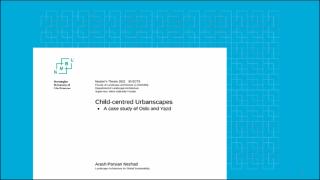| dc.description.abstract | Childhood is one of the most critical developmental stages in human life, powerfully contributing to the productivity of society at large. Although there is evidence about the influence of physiological factors on early childhood development, the effect of the physical environment is less well investigated. Furthermore, many countries exclude children from most land use planning practices. Therefore, this thesis investigates the role of urbanscapes on children’s well-being and development.
The materials were collected using the purposive sampling method. Countries were selected based on the number of initiatives and the availability of information. Ideas from eight scholars, six international programmes, and the aims of more than forty programmes in fifteen countries worldwide were investigated.
Based on the literature review, six essential topics were identified for further exploration, of which, Spatial characteristics of the built environment, Safety, and Independent mobility were chosen for analysis in the two case studies.
Observational techniques and reading of the urbanscape were the methodologies used for the two case studies in Oslo and Yazd. The observation was conducted as a complete observer and covert to the subjects to minimise the Hawthorne effect. Subjects’ reactions to different urbanscape settings were collected through field notes, maps, sketches and photographs.
By analysing the case studies, it was understood that: children are attracted to spaces that provide unrestricted movement, exploration opportunities, and risk-taking activities in comfort conditions. An uninterrupted pedestrian network complemented with design features such as pausing/resting spots, visual corridors, and attractive destinations encourages children to walk more. Multifunctionality of the spaces, commercial-oriented edges, and mixed land use invite different people to urban areas and increase the perception of safety in children.
Recommendations were made based on the findings. | |
